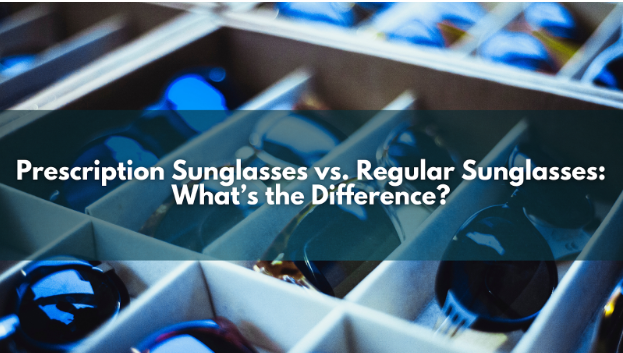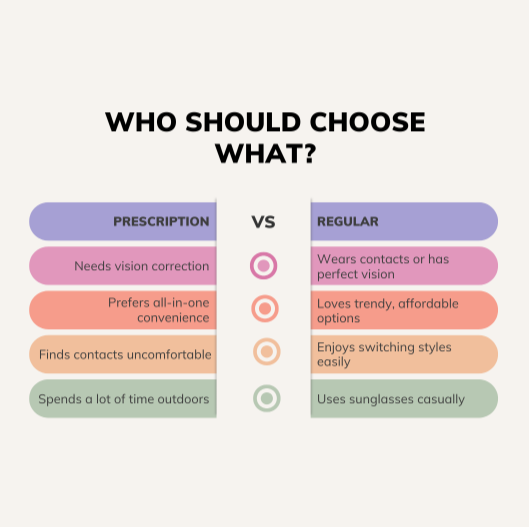Think about your last vacation, road trip, or even just a walk through the park. How many times did you switch between regular glasses and sunglasses? Struggle with putting contacts in just to wear shades? Or worse—choose between clear vision and sun protection? The debate between prescription and regular sunglasses isn’t just about clarity—it’s about eliminating tiny daily frustrations that add up over time.
Sunglasses serve one main purpose: protecting your eyes from harmful UV rays and reducing glare. But if you wear prescription glasses, you face an extra challenge—finding the best prescription sunglasses or opting for regular ones with an alternative solution like contacts or clip-on. So, which option makes more sense for your needs? Let’s break it down.

What Are Prescription Sunglasses?
When comparing prescription sunglasses vs. regular sunglasses, the key difference lies in vision correction. While regular sunglasses protect against UV rays and reduce glare, they do not address refractive errors like nearsightedness or farsightedness.
The best prescription sunglasses combine vision correction with sun protection, allowing you to see clearly while shielding your eyes from UV rays and glare. These sunglasses work just like regular prescription glasses but with tinted lenses to block sunlight.
Types of Prescription Sunglasses
- Single-Vision Prescription Sunglasses – These correct nearsightedness or farsightedness and are great for everyday wear.
- Bifocal & Progressive Prescription Sunglasses – If you need multiple focal points, these options help you switch between different vision needs without swapping glasses.
- Polarized Prescription Sunglasses – These reduce glare from surfaces like water and pavement, making them a top choice for driving or outdoor activities.
- Photochromic Prescription Sunglasses – Also known as transition lenses, these adjust to changing light conditions.
- Blue-Light Filtering Prescription Sunglasses – These protect your eyes from digital screen strain while offering UV protection.
- High-Index Prescription Sunglasses – These lenses are thinner and lighter, making them ideal for stronger prescriptions.
Who Benefits from Prescription Sunglasses?
- People who need clear vision at all times.
- Anyone who finds contact lenses uncomfortable.
- Those who spend a lot of time outdoors and need eye protection.
- Individuals looking for a convenient, all-in-one solution.
- Athletes or drivers who require both clarity and sun protection.
What Are Regular Sunglasses?
Regular sunglasses are designed to protect your eyes from UV rays and reduce glare, but they don’t provide vision correction. Many brands offer stylish options with varying levels of lens technology.
Types of Regular Sunglasses
- Tinted Lenses – These come in different shades and intensities to reduce brightness.
- Polarized Lenses – Designed to minimize glare, they are perfect for driving and outdoor activities.
- Mirrored Lenses – These have a reflective coating that decreases light exposure.
- Gradient Lenses – These transition from darker at the top to lighter at the bottom, ideal for driving.
- Blue-Light Blocking Lenses – Reduce eye strain from digital screens.
- Photochromic Lenses – Although not prescription, these lenses adjust to UV exposure.
- UV400 Protection Lenses – Offer full protection against harmful UVA and UVB rays.
Who Benefits from Regular Sunglasses?
- People who wear contact lenses.
- Anyone who doesn’t require prescription glasses.
- Those who prioritize fashion, affordability, and a wider selection of styles.
- Individuals who want sunglasses readily available at any time.
- Outdoor enthusiasts who don’t need vision correction.
Key Differences Between Prescription and Regular Sunglasses
Vision Correction
Prescription sunglasses offer clear vision tailored to your eyesight needs, while regular sunglasses provide only UV and glare protection. If you need prescription lenses, wearing regular sunglasses alone won’t improve your vision.
Cost
The best prescription sunglasses cost more than standard pairs due to custom-made lenses, but they eliminate the need for additional eyewear. Regular sunglasses are more budget-friendly and widely available.
Convenience
Prescription sunglasses remove the hassle of switching between glasses and sunglasses. Regular sunglasses work for everyone, but if you need vision correction, you’ll need an alternative like contact lenses or clip-on.
Lens Customization
Prescription sunglasses come with more lens options, including anti-glare coatings, blue light filters, and transitional lenses that adjust to lighting changes. Regular sunglasses offer a broader range of styles and trendy designs.
Availability
Regular sunglasses are available everywhere, from gas stations to designer boutiques. Prescription sunglasses require an eye exam and custom lens production, making them less convenient to buy on the spot.
Pros and Cons of Each Option
Prescription Sunglasses
Pros:
- Clear vision and sun protection in one pair.
- No need for clip-ons or transition lenses.
- Available with high-tech lens coatings.
- Better for outdoor sports and driving due to polarization.
- It can be customized for specific vision needs.
Cons:
- They are more expensive than regular sunglasses.
- Requires a prescription and special order.
- Fewer options for trendy designs.
Regular Sunglasses
Pros:
- Affordable and widely available.
- Comes in countless styles.
- It can be worn over contact lenses.
- Easy to replace or upgrade.
- More accessible at retail stores.
Cons:
- No vision correction.
- It might not include high-quality lens coatings.
- Requires an additional solution if you need prescription lenses.
Choosing the Right Option for You
Deciding between prescription and regular sunglasses depends on several factors.
- Do you need vision correction? If so, prescription sunglasses are the best choice for seamless clarity and UV protection.
- What’s your budget? If you’re looking for affordability, regular sunglasses with contact lenses may be a better fit.
- How active is your lifestyle? If you spend a lot of time outdoors, investing in the best prescription sunglasses with polarization can enhance comfort and visibility.
- Do you value convenience over customization? Prescription sunglasses remove the hassle of switching eyewear, while regular sunglasses offer more styles.
- Are you looking for fashion or function? Regular sunglasses come in endless styles, while prescription sunglasses are more functional.
Alternative Solutions
If you’re not ready to commit to prescription sunglasses, here are a few workarounds:
- Contact Lenses + Regular Sunglasses – Wear regular sunglasses over your contact lenses for flexibility.
- Photochromic (Transition) Lenses – These adjust to changing light conditions, offering a hybrid solution.
- Clip-On Sunglasses – Attach these to your regular prescription glasses for sun protection on demand.
- Over-Prescription Sunglasses – These larger frames fit over existing prescription glasses.
- Sport-Specific Goggles with Prescription Inserts – Ideal for athletes who need vision correction outdoors.
Conclusion
Both prescription and regular sunglasses have their advantages, but the right choice depends on your lifestyle and vision needs. If you want convenience and clear vision outdoors, prescription sunglasses are a game-changer. If you’re more focused on affordability and style variety, regular sunglasses might be a better fit. Whatever you choose, protecting your eyes from UV rays should always be a priority.
When looking for the best prescription sunglasses, prioritize quality lenses and UV protection to ensure long-term eye health. Whether you go prescription or regular, make sure your shades support both your vision and your lifestyle.
FAQs
Are prescription sunglasses worth the investment compared to regular sunglasses?
Yes, they provide seamless vision correction and UV protection without the hassle of switching glasses. If you rely on prescription eyewear, they offer unmatched convenience and clarity.
Can I get prescription sunglasses with polarized or transition lenses?
Absolutely—many prescription sunglasses come with polarized lenses to reduce glare or transition lenses that adjust to lighting. These options enhance comfort and adaptability for various environments.
How do prescription sunglasses compare in durability and maintenance to regular sunglasses?Prescription sunglasses often use high-quality materials and coatings, making them more durable than cheap regular sunglasses. However, they require proper care to prevent scratches and ensure long-lasting clarity.












